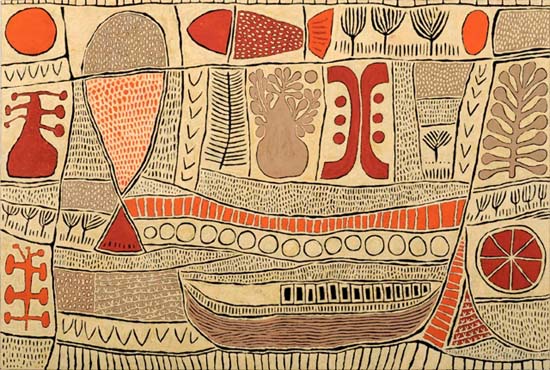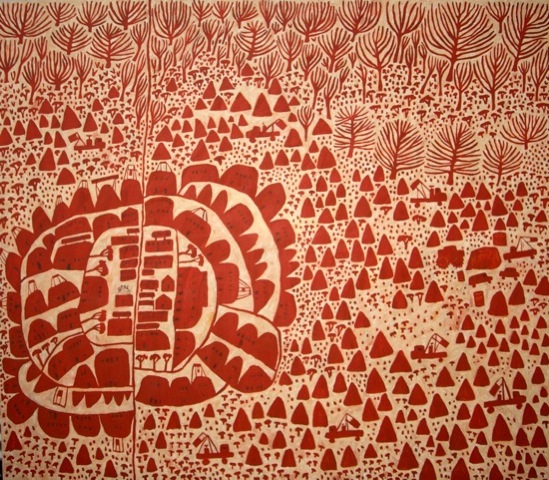Sharne Wolff is struck by colour at Marina Strocchi’s latest exhibition…
As has been the case with every exhibition of Marina Strocchi’s I’ve seen – it’s the colours that strike me first. Perhaps it’s the fact that these ochres and reds, burnt oranges and pinky greys are just as out of place in a city gallery as they are familiar in the desert. Strocchi lives and works in Central Australia where the colours are rich and dynamic and, whether willing or not, you are completely immersed in nature. It is not surprising that both elements play a large part in the current exhibition at Brisbane’s Jan Murphy Gallery entitled North and South.
Marina Strocchi, Pictograph With Fish, 2011. Acrylic on linen, 122.5 x 183.0 cm.
Strocchi’s paintings, just like the artist herself, are not easy to categorise. Strocchi’s father was one of many post-war Italian migrants who travelled to Australia to begin a new life in an unfamiliar world. Strocchi was born and educated in Melbourne, and later at the Sorbonne in Paris, before eventually visiting and moving to Alice Springs in the early 1990’s. She became a founding coordinator at the Ikuntji Art Centre in the Northern Territory (often referred to as Haasts Bluff) in 1992, and it is these years spent in the desert living with and assisting aboriginal artists to make and exhibit their work that has clearly had a profound influence on her work. Collaboration with other members of the original Roar Group from Melbourne (which includes her artist partner Wayne Eager and artist David Larwill) has no doubt also played some part. Ikunji nestles in the spectacular West MacDonnell ranges a couple of hundred kilometres outside Alice Springs and a world away from everywhere.
Marina Strocchi, Coober Pedy from the North, 2011. Acrylic on linen, 175x200cms.
Strocchi’s paintings are heavy in narrative. They tell stories of the desert in a lyrical manner. There’s some whimsy there too. Like many indigenous artists these works use symbols to tell stories, although the motifs developed by Strocchi can usually be distinguished from those of the traditional desert painters. On the afternoon of the show’s opening trees, animals, camels, rabbits, grasses, fish, dogs and termite mounds kept the children in the Gallery happy and occupied, while they counted up as many as they could find in each work. Strocchi fills the entire canvas with her ‘landscapes’ repeating symbols over and over and transforming some into tapestry-like pieces reminiscent of those made by Pacific Island peoples such as the Fijian tapas. Although many reviews of Strocchi’s work refer to it as ‘abstract’, Strocchi’s symbols have developed into a recognisable language of icons – unique to her work but certainly representations of things that exist in the real world. When you’ve seen a real boab tree or mangrove roots like those Strocchi paints, you’re able to identify more strongly with these works.
In some works the colour contrasts are strong – Pictograph with Fish 2011 uses strong black line to distinguish one area of the painting from another. In others like Mimili Area 2011 the colour has been downplayed – perhaps to reflect the colours of the early morning or late afternoon where colours fade and blur into one another.
Marina Strocchi, Young River Gums, 2011. Acrylic on linen, 153×183 cm.
The artist’s newer works are different to the familiar landscapes of recent exhibitions. In particular, Coober Pedy 2011 illustrates the town of Coober Pedy, seen from above in a swirling spiral of orange with cut out houses and shops – like an animated aerial map. Although there are no figures evident in the painting this is very much an urban scene. Details of the shops and major locations in the town have been written in a naïve text style as if made by a child. Many houses in the town are of course underground, windows are few and vegetation even harder to find. Trucks and mine shafts identify the business of place and the roads form the overall pattern. In titling the work a pictograph, the artist is stating her intentions- to identify the town in symbolic form.
Marina Strocchi
North and South
Jan Murphy Gallery Brisbane
until December 3




Absolutely stunning artwork. Thanks so much for introducing me, I am an instant fan.